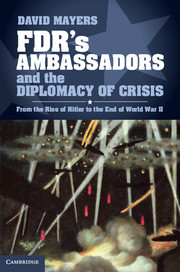8 - Conclusions: US Diplomacy and War
from Part III - Victors
Published online by Cambridge University Press: 05 December 2012
Summary
Roosevelt left behind a sparse paper trail, discouraging to biographers and diplomatic historians alike. No private diary or self-revealing letters written during his presidential years reside in the public domain, a result being that the mind and intentions of FDR remain hazy. Consequently, one is obliged to judge the quality of his statecraft by reference – at least in part – to the people that he appointed to high office, not only cabinet secretaries but also ambassadors assigned to key capitals.
From instinct rather than ratiocination, Roosevelt divined that statesmen do not make history. It is a given, like the sea, in which deep currents run: inconstant fortuna, unpredictable scientific innovation, blind economic forces, competitions of power oblivious to finer feeling. These lines by Henry Wadsworth Longfellow were among FDR's favorites (sent to Churchill during a dire moment for Great Britain, January 1941):
Sail on, O ship of State!
Sail on, O Union, strong and great!
Humanity with all its fears,
With all the hopes of future years,
Is hanging breathless on thy fate!
- Type
- Chapter
- Information
- FDR's Ambassadors and the Diplomacy of CrisisFrom the Rise of Hitler to the End of World War II, pp. 249 - 259Publisher: Cambridge University PressPrint publication year: 2012



